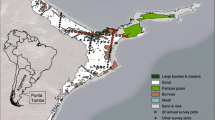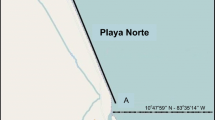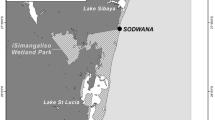Abstract
Although many species of marine mega-vertebrates are threatened as a result of human activity, some populations are showing promising signs of recovery following decades of protection. In this study, we report on the status of the South Atlantic’s largest green turtle (Chelonia mydas) nesting aggregation at Ascension Island, 70 years after legal protection and the cessation of commercial turtle harvesting that decimated the population. Using a monitoring dataset spanning 36 years, we modelled long-term trends in nesting activity at both a rookery level and across individual nesting beaches and beach clusters. Since monitoring began in 1977, the average number of green turtle clutches deposited annually at Ascension Island has increased sixfold, from approximately 3,700 to 23,700; a trend that has been accompanied by a significant decrease in the average size of nesting females. Interestingly, however, rates of increase in nesting activity have varied dramatically among nesting beaches, ranging from 0.4 to 6 % growth per annum. More than 97 % of this variation could be explained by distance from the main human settlement of Georgetown—the historic centre of turtle harvesting—with beaches closer to Georgetown experiencing the most rapid growth. More rapid population growth close to human centres seems counterintuitive, but may reflect the more intensive depletion of these accessible, local stocks during the harvesting era. Overall, the Ascension Island green turtle population appears to be recovering strongly, mirroring positive trends for this species across many parts of its geographic range. While not a cause for complacency, these trends are encouraging and demonstrate the capacity of marine megafauna to rebound when anthropogenic pressures are alleviated through conservation action.





Similar content being viewed by others
References
Almeida AP, Moreira LMP, Bruno SC, Thomé JCA, Martins AS, Bolten AB, Bjorndal KA (2011) Green turtle nesting on Trindade Island, Brazil: abundance, trends and biometrics. Endang Species Res 14:193–201
Balazs GH, Chaloupka M (2004a) Thirty-year recovery trend in the once depleted Hawaiian green sea turtle stock. Biol Conserv 117:491–498
Balazs GH, Chaloupka M (2004b) Spatial and temporal variability in somatic growth of green sea turtles (Chelonia mydas) resident in the Hawaiian Archipelago. Mar Biol 145:1043–1059
Bellini C, Santos AJB, Grossman A, Marcovaldi MA, Barata PCR (2013) Green turtle (Chelonia mydas) nesting on Atol das Rocas, north-eastern Brazil, 1990–2008. J Mar Biol Assoc UK 93:1117–1132
Bjorndal KA, Bolten AB (2003) From ghosts to key species: restoring sea turtles to fulfil their ecological roles. Mar Turt Newsl 100:16–21
Bjorndal KA, Bolten AB, Chaloupka M (2000) Green turtle somatic growth model: evidence for density dependence. Ecol Appl 10:269–282
Bjorndal KA, Bolten AB, Moreira L, Bellini C, Marcovaldi MA (2006) Population structure and diversity of Brazilian green turtle rookeries based on mitochondrial DNA sequences. Chelonian Conserv Biol 5:262–268
Bowen BW, Karl SA (2007) Population genetics and phylogeny of sea turtles. Mol Ecol 16:4886–4907
Broderick AC, Godley BJ, Hays GC (2001) Trophic status drives interannual variability in nesting numbers of marine turtles. Proc R Soc B 268:1481–1487
Broderick AC, Glen F, Godley BJ, Hays GC (2003) Variation in reproductive output of marine turtles. J Exp Mar Biol Ecol 288:95–109
Broderick AC, Frauenstein R, Glen F, Hays GC, Jackson AL, Pelembe T, Ruxton GD, Godley BJ (2006) Are green turtles globally endangered? Glob Ecol Biogeogr 15:21–26
Browne DC, Horrocks JA, Abreu-Grobois FA (2010) Population subdivision in hawksbill turtles nesting on Barbados, West Indies, determined from mitochondrial DNA control region sequences. Conserv Genet 11:1541–1546
Chaloupka M, Bjorndal KA, Balazs GH, Bolten AB, Ehrhart LM, Limpus CJ, Suganuma H, Troëng S, Yamaguchi M (2008) Encouraging outlook for recovery of a once severely exploited marine megaherbivore. Glob Ecol Biogeogr 17:297–304
Dutton DL, Dutton PH, Chaloupka MC, Boulon RH (2005) Increase of a Caribbean leatherback turtle Demochelys coriacea nesting population linked to long-term nest protection. Biol Conserv 126:186–194
Fletemeyer J (1986) Ascension Island turtles still in trouble. Mar Turt Newsl 37:11
Girondot M (2010) Estimating density of animals during migratory waves: a new model applied to marine turtles at nesting sites. Endang Species Res 12:95–105
Godfrey MH, Godley BJ (2008) Seeing past the red: flawed IUCN global listings for sea turtles. Endang Species Res 6:155–159
Godley BJ, Broderick AC, Hays GC (2001) Nesting of green turtles (Chelonia mydas) at Ascension Island, South Atlantic. Biol Conserv 97:151–158
Hawkes LA, Broderick AC, Godfrey MH, Godley BJ (2009) Climate change and marine turtles. Endang Species Res 7:137–154
Hays GC, Adams CR, Speakman JR (1993) Reproductive investment by green turtles nesting on Ascension Island. Can J Zool 71:1098–1103
Hays GC, Broderick AC, Godley BJ, Lovell P, Martin C, McConnell BJ, Richardson S (2002a) Biphasal long-distance migration in green turtles. Anim Behav 64:895–898
Hays GC, Broderick AC, Glen F, Godley BJ (2002b) Change in body mass associated with long-term fasting in a marine reptile: the case of green turtles (Chelonia mydas) at Ascension Island. Can J Zool 80:1299–1302
Heppell SS, Crouse DT, Crowder LB, Epperly S, Gabriel T, Henwood T, Marquez R, Thompson N (2005) A population model to estimate recovery time, population size, and management impacts on Kemp’s ridleys. Chelonian Conserv Biol 4:767–773
Huxley RC (1997) Ascension Island and turtles: a monograph. Ascension Island Heritage Society, Ascension Island
Huxley RC (1999) Historical overview of marine turtle harvesting, Ascension Island, South Atlantic Ocean. Mar Turt Newsl 84:7–9
Jackson JBC, Kirby MX, Berger WH, Bjorndal KA, Botsford LW, Borque BJ, Bradbury RH, Cooke R, Erlandson J, Estes JA, Hughes TP, Kidwell S, Lange CB, Lenihan HS, Pandolfi JM, Peterson CH, Steneck RS, Tegner MJ, Warner RR (2001) Historical overfishing and the recent collapse of coastal ecosystems. Science 293:629–637
Jackson AL, Broderick AC, Fuller WJ, Glen F, Ruxton GD, Godley BJ (2008) Sampling design and its effect on population monitoring: how much monitoring do turtles really need? Biol Conserv 141:2932–2941
Kelkar N, Arthur R, Marbà N, Alcoverro T (2013) Greener pastures? High-density feeding aggregations of green turtles precipitate species shifts in seagrass meadows. J Ecol 101:1158–1168
Kittinger JN, Van Houtan KS, McClenachan LE, Lawrence AL (2013) Using historical data to assess the biogeography of population recovery. Ecography 36:868–872
Lal A, Arthur R, Marbà N, Lill AWT, Alcoverro T (2010) Implications of conserving an ecosystem modifier: increasing green turtle (Chelonia mydas) densities substantially alters seagrass meadows. Biol Conserv 143:2730–2738
Marcovaldi MÂ, Marcovaldi GG (1999) Marine turtles of Brazil: the history and structure of Projecto TAMAR-IBAMA. Biol Conserv 91:35–41
McClenachan L, Jackson JBC, Newman MJH (2006) Conservation implications of historic sea turtle nesting beach loss. Front Ecol Environ 4:290–296
Mortimer JA, Carr A (1987) Reproduction and migrations of the Ascension Island green turtle (Chelonia mydas). Copeia 1987:103–113
Mortimer JA, Portier KM (1989) Reproductive homing and interesting behaviour of the green turtle (Chelonia mydas) at Ascension Island, South Atlantic Ocean. Copeia 1989:962–977
Mortimer JA, von Brandis RG, Liljevik A, Chapman R, Collie J (2011) Fall and rise of nesting green turtles (Chelonia mydas) at Aldabra Atoll, Seychelles: positive response to four decades of protection (1968–2008). Chelonian Conserv Biol 10:165–176
Naro-Maciel E, Bondioli AC, Martin M, Almeida AP, Baptistotte C, Bellini C, Marcovaldi MÂ, Santos AJ, Amato G (2012) The interplay of homing and dispersal in green turtles: a focus on the southwestern atlantic. J Hered 103:792–805
National Research Council (2010) Assessment of sea turtle status and trends: integrating demography and abundance. National Academies Press, Washington
Pritchard PCH (2004) Long-term sea turtle nesting cycles in the Guianas. In: Coyne MS, Clark RD (eds) Proceedings of the 21st Annual Symposium on Sea Turtle Biology and Conservation. NOAA Technical Memorandum NMFS-SEFSC-528, pp. 66–68.
Prosdocimi L, Carman VG, Albareda DA, Remis MI (2012) Genetic composition of green turtle feeding grounds in coastal waters of Argentina based on mitochondrial DNA. J Exp Mar Biol Ecol 412:37–45
Seminoff JA (2004) MTSG global assessment of green turtles (Chelonia mydas) for the IUCN Red List. IUCN Species Survival Commission, Cambridge
Seminoff JA, Shanker K (2008) Marine turtles and IUCN red listing: a review of the process, the pitfalls, and novel assessment processes. J Exp Mar Biol Ecol 356:52–68
Shamblin BM, Bjorndal KA, Bolten AB, Hillis-Starr ZM, Lundgren I, Naro-Maciel E, Nairn CJ (2012) Mitogenonic sequences better resolve stock structure of southern Greater Caribbean green turtle rookeries. Mol Ecol 21:2330–2340
Simon MH, Parkes AS (1976) The green sea turtle (Chelonia mydas) nesting on Ascension Island. J Zool 179:153–163
Spotila JR, Reina RD, Steyermark AC, Plotkin PT, Paladino FV (2000) Pacific leatherback turtles face extinction. Nature 405:529–530
Stevick PT, Allen J, Clapham PJ, Friday N, Katona SK, Larsen F, Lien J, Mattila DK, Palsbøll PJ, Sigurjónsson J, Smith TD, Øien N, Hammond PS (2003) North Atlantic humpback whale and rate of increase four decades after protection from whaling. Mar Ecol Prog Ser 258:263–273
Stewart K, Sims M, Meylan A, Witherington B, Brost B, Crowder LB (2011) Leatherback nests increasing significantly in Florida, USA; trends assessed over 30 years using multilevel modelling. Ecol Appl 21:263–273
Troëng S, Rankin E (2005) Long-term conservation efforts contribute to positive green turtle Chelonia mydas nesting trend at Tortuguero, Costa Rica. Biol Conserv 121:111–116
Weber SB, Broderick AC, Groothuis TGG, Ellick J, Godley BJ, Blount JD (2012) Fine-scale thermal adaptation in a green turtle nesting population. Proc R Soc B 279:1077–1084
Weber N, Weber SB, Godley BJ, Ellick J, Witt M, Broderick AC (2013) Telemetry as a tool for improving estimates of marine turtle abundance. Biol Conserv 167:90–96
Witherington BE, Koeppel CM (2000) Sea turtle nesting in Florida, USA, during the decade 1989–1998: an analysis of trends. In: Kalb H, Wibbels T (eds) Proceedings of the 19th Annual Symposium on Sea Turtle Biology and Conservation. NOAA Technical Memorandum NMFS-SEFSC-443, pp. 94–96.
Witherington BE, Kubilis P, Brost B, Meylan A (2009) Decreasing annual nest counts in a globally important loggerhead sea turtle population. Ecol Appl 19:30–54
Wood SN (2004) Stable and efficient multiple smoothing parameter estimation for generalized additive models. J Am Stat Assoc 99:673–686
Acknowledgments
This work was funded by the UK Government’s Department for Environment food a Rural Affairs (DEFRA) through the Overseas Territories Environment Programme (OTEP) and the Darwin Initiative. The authors would like to thank T. Weber and A. Jackson for help with population models, and the many volunteer ‘rakers’ who have contributed to turtle monitoring over the years. We are grateful to the Associate Editor and two anonymous reviewers for comments and suggestions that substantially improved an earlier draft of the manuscript.
Author information
Authors and Affiliations
Corresponding authors
Additional information
Communicated by Simon Ingram.
Electronic supplementary material
Below is the link to the electronic supplementary material.
Rights and permissions
About this article
Cite this article
Weber, S.B., Weber, N., Ellick, J. et al. Recovery of the South Atlantic’s largest green turtle nesting population. Biodivers Conserv 23, 3005–3018 (2014). https://doi.org/10.1007/s10531-014-0759-6
Received:
Revised:
Accepted:
Published:
Issue Date:
DOI: https://doi.org/10.1007/s10531-014-0759-6




